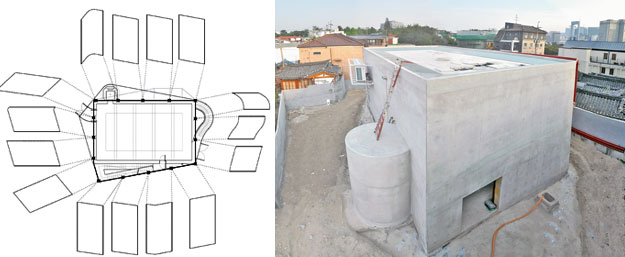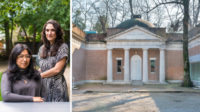Seoul
The art world debunked the myth of the neutrality of the white-box gallery long ago. When it comes to displaying art, it's impossible to create an impartial context that will—white walls and concrete floors be damned—silently recede or disappear. That doesn't mean there aren't new and novel ways of trying. For its 13,500 square-foot Kukje Gallery building in Seoul, the New York City firm Solid Objectives – Idenburg Liu (SO – IL) tinkered with the idea of dissolving the gallery envelope—not from within, but from the outside. And they did it using chain mail.
Kukje is located in Seoul's Samcheong-ro area, a part of town it helped transform into the Korean capital's blue-chip gallery district when the space opened there in 1982. Since then, the scale of contemporary works has grown in tandem with the neighborhood's burgeoning art scene, where numerous high-profile galleries and modern art centers are now firmly ensconced. Showing such space-hungry artists as Anselm Kiefer and Louise Bourgeois, Kukje expanded its first building over the years, and added a second one next door in 2007.
All of this growth has taken place not in some former industrial zone with capacious warehouse spaces but in a tight-knit historic neighborhood adjacent to the Joseon Dynasty–era Gyeongbokgung Palace. The area's dense layering of converted hanok houses left barely enough room for Kukje to add a third building to its compound, and SO – IL needed to make the most of the plot. “They hoped we could make the biggest box legally possible on the site,” partner Florian Idenburg says of the client. Idenburg and his wife, Jing Liu, the firm's other partner, began by responding to the program literally. Hemmed in on nearly all sides by existing, irregularly shaped buildings, they inserted a simple, concrete box—52 feet long by 31 feet wide by 18 feet high—that filled the maximum allowable volume, leaving just enough space around it to not feel cramped. To maintain the purity of the box, a single gallery, the architects pulled out circulation functions so they protrude from the building's exterior: a concrete cylinder for the elevator; a metal stair leading to a roof garden; a swoop of curving glass descending to the basement. “It's a very diagrammatic building,” says Liu. “Basically we took the optimal gallery proportions and then added a stair, an elevator. Everything just is what it is.”
But having ticked off “austere white cube” on the checklist of gallery design strategies (perhaps with a wink and a nudge), Liu and Idenburg proceeded to, in a sense, undo their work. Best known for their temporary structures, including the recent 225,000-square-foot tent that housed the Frieze Art Fair in New York this May, the partners demonstrate no proclivity for monumentality. Indeed, they wanted to tone down their impressive concrete box in a way that showed deference to the surrounding urban fabric, to “make it less harsh and singular, to soften it,” Idenburg says.
“We also needed something that would do what the rest wasn't doing—tie all the pieces together,” Liu adds. “So essentially we shrink-wrapped [the building].”
After stretching a number of materials, including elastic stockings, over models of the gallery during the design process, Idenburg and Liu settled on chain mail. Existing varieties, however, such as those used for butcher gloves, didn't cut it for their purpose. “We needed something that worked at the scale of architecture, not the body,” says Idenburg. They found a fabricator in China that could hand-make the chain mail at a custom size, with 1.5-inch-diameter rings. They also retained the U.S.- and Hong Kong–based facade-engineering firm Front to help develop an application strategy, using computer modeling, so that the mesh skin would assume the complex curves needed to stretch over the building and its protrusions. In the end, the design team devised a system of 15 panels totaling 500,000 hand-welded rings that would be stitched together, also by hand, into a seamless, all-encompassing veil.
The result is intriguing, transforming the structure into an object that's simultaneously amorphous and geometric, solid and permeable—and seemingly an object at the same time that it appears not to be one. In certain light, the chain mail turns nearly diaphanous, like an invisibility cloak at half power. In others, it verges on kinky. The sexual connotation is probably not entirely unintentional. (SO – IL, after all, is the firm that once named its installation at New York City's MoMA PS1 Pole Dance.) The one exterior section not covered by the mesh is an elegantly curving glass wall.
Kukje's expansion has pushed its small campus—for which SO – IL also designed landscaping and made alterations to the existing buildings—toward a back street, where there is an entrance in the glass facade. The glazing also encloses a stair that descends to a basement level with an office and a 60-seat auditorium, and a subbasement for storage. Meanwhile, the exterior metal stair ascends to a roof terrace with a ring of perimeter skylights that offer views down into the white, column-free gallery below. This stair is “the only place that people can occupy between the mesh skin and the concrete box,” says Liu. It's also the most perversely sensual, placing you as it does inside what's possibly the world's biggest fishnet stocking. Perhaps SO – IL's K3 gallery is not so much a dematerialization of the white-box paradigm but a representation of its evolution (and that of contemporary art in general) as something more fetishistic. Which isn't necessarily a bad thing.
“He was very happy with the building,” Idenburg says of Paul McCarthy, the artist whose notoriously twisted and hilariously depraved work inaugurated the gallery. “He said it was very suitable.”
Aric Chen is a Beijing-based writer and curator.
Thinking outside the box— to wrap it in rings of steel

|
| Photo © Front |
| A C-channel and special connections above the parapet await the attachment of the chain mail mesh. |
Given that wrapping a building in chain mail is not common practice, developing the mesh skin for the Kukje Gallery required essentially starting from scratch. Once a fabricator was found to custom-make and weld the 1.5-inchdiameter rings, the key was figuring out how to ensure that the mesh would always fit precisely and snugly over the building's complex shape.
SO ' IL looked to the facade engineering firm Front for help. 'It was our first encounter with such a strange and primitive material,' says Na Min Ra, a Front partner based in San Francisco. After testing samples, Ra realized the mesh reacted differently depending on its orientation: stiff in one direction, and loose when rotated 90 degrees. Choosing the latter, he developed a computer model using Rhino 5 to determine how the mesh should be fabricated. This required more testing. 'We employed a physical/digital feedback process by which studies of [1:1 and 1:10] physical mock-ups, of increasing scale and complexity, would inform the continuous refinement of the working digital model,' says Ra.
In the end, the 500,000 rings of 316 grade stainless steel' stretched, coiled, scored, linked, welded by hand, and finished, all at VIA in Anping, China'were shipped to Seoul in 15 swaths of 20,000 to 40,000 rings each. Once on-site, each was attached to an I-beam and lifted to the building's parapet, where special connections along the top edge were slid into a C-channel. This allowed flexibility of movement so the mesh could settle into its own form. Each swath was similarly attached at the bottom, just below the ground pavers, and then hand-linked, ring by ring, to the one next to it. Finally, the entirety was tightened to achieve the right tension. The finish of the rings welded on-site also needed to match that of the bead-blasted rings throughout.
Other elements, such as spherical nodes at corners and individually adjusted turnbuckles, add pliability. When you've got heat, cold, wind, and gravity working against you to induce sagging, wrinkling, and bunching, a little wiggle room helps. A.C.

|
| Photo courtesy SO ' IL |
| SO – IL wanted to soften the concrete building, seen here before the addition of the chain mail mesh. |
Completion Date: April 2012
Size: 32,290 square feet (gross) / 13,500 square feet (building)
Cost: Witheld
Architect and Site Design:
SO – IL
68 Jay Street, #501
Brooklyn, New York
USA 11201
Ph: 718 - 624-6666
office@so-il.org
PeopleOwner: Kukje Gallery
Architect:
Personnel in architect's firm who should receive special credit: Architect of record: Jong -Ga Architects Interior designer: SO – IL
Engineers: Mechanical Engineer: J.K. Technology
Consultant(s): Team: M. Min Ra, Jeffrey Kock, Benjamin Bradley, Evan Levelle, Koshi Kawakami
Landscape design and construction: Graphic: 2 x 4
Theatre consultant and contractor:
General Contractor: Photographer: Iwan Baan |
Products
Structural system:
Unique cladding Exterior cladding: VIA LLC, San Francisco, Hong Kong Façade Hardware: VIA LLC, San Francisco, Hong Kong
Roofing Glass: Curved Low-Iron Laminated Glass, HANGLASS Skylights: Standard IGU Laylights: BARRISOL & MechoShade
Entrances Sliding doors: B&C Panel
Hardware Closers: HAFELLE Pulls: Jin-Gwan Metal Fabricators Security devices: Samsung security system
Interior finishes Cabinetwork and custom woodwork: Vitamin Design Paints and stains: SAMWHA Floor and wall tile: LISTONE GIORDANO (theater), BISAZZA (restroom),
Furnishings Fixed seating: BAOBAP furniture Upholstery: BAOBAP furniture
Lighting Downlights: FLOS Anteras Exterior: LED Dimming System or other lighting controls: GIRA Elevators/Escalators: FEELUX florescent light
Plumbing |













Post a comment to this article
Report Abusive Comment